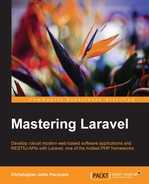We have seen this controller before, but here are a few examples. The single most simple example of a RESTful call would be as shown in the following sections.
Create a GET call to http://www.hotelwebsite.com/accommmodations/1, where 1 would be the ID of the room:
/**
* Display the specified resource.
*
* @param int $id
* @return Response
*/
public function show($id)
{
return MyCompanyAccommodation::findOrFail($id);
}This would return a single model as a JSON-encoded object:
{
"id": 1,
"name": "Hotel On The Hill","description":"Lorem ipsum dolor sit amet, consectetur adipiscing elit.",
"location_id": 1,
"created_at": "2015-02-08 20:13:10",
"updated_at": "2015-02-08 20:13:10",
"deleted_at": null
}Create a GET call to http://www.hotelwebsite.com/accommmodations.
This is similar to the preceding code, yet slightly different:
/** Display a listing of the resource.
* @return Response
*/
public function index()
{
return Accommodation::all();
}This would return all of the models, automatically encoded as JSON objects; there is nothing else that is required. Formatting has been added so that the JSON results are more easily readable, but basically, the entire model is returned:
[{
"id": 1,
"name": "Hotel On The Hill","description":"Lorem ipsum dolor sit amet, consectetur adipiscing elit.",
"location_id": 1,
"created_at": "2015-02-08 20:13:10",
"updated_at": "2015-02-08 20:13:10",
"deleted_at": null
}
{ "id": 2,
"name": "Patterson Place",
"description": "Lorem ipsum dolor sit amet, consectetur adipiscing elit.",
"location_id": 2,
"created_at": "2015-02-08 20:15:02",
"updated_at": "2015-02-08 20:15:02",
"deleted_at": null
},
{
"id": 3,
"name": "Neat and Tidy Hotel",
"description": "Lorem ipsum dolor sit amet, consectetur adipiscing elit.",
"location_id": 3,
"created_at": "2015-02-08 20:17:34",
"updated_at": "2015-02-08 20:17:34",
"deleted_at": null
}
]To add pagination, simply substitute all() with paginate():
public function index()
{
return Accommodation::paginate();
}The results will now look like this. The eloquent collection array is now moved inside a date attribute:
{"total":15,
"per_page":15,
"current_page":1,
"last_page":1,
"next_page_url":null,
"prev_page_url":null,
"from":1,
"to":15,
"data":[{"id":9,
"name":"Lovely Hotel",
"description":"Lovely Hotel Greater Pittsburgh",
….Create a POST call to http://www.hotelwebsite.com/accommmodations.
To create a new model, a POST call will be sent to /accommodations. A JSON would be sent from the frontend as follows:
{
"name": "Lovely Hotel",
"description": "Lovely Hotel Greater Pittsburgh",
"location_id":1
}The store function might look something like this:
public function store()
{
$input = Input::json();
$accommodation = new Accommodation;
$accommodation->name = $input->get('name'),
$accommodation->description = $input->get('description'),
$accommodation->location_id = $input->get('location_id'),
$accommodation->save();
return response($accommodation, 201)
;
}In this example, we returned the model as a JSON-encoded object. The object will include the ID that was inserted:
{
"name":"Lovely Hotel",
"description":"Lovely Hotel Greater Pittsburgh",
"location_id":1,
"updated_at":"2015-03-13 20:48:19",
"created_at":"2015-03-13 20:48:19",
"id":26
}Create a PUT call to http://www.hotelwebsite.com/accommmodations/1, where 1 is the ID to be updated:
/**
* Update the specified resource in storage.
*
* @param int $id
* @return Response
*/
public function update($id)
{
$input = Input::json();
$accommodation = MyCompanyAccommodation::findOrFail($id);
$accommodation->name = $input->get('name'),
$accommodation->description = $input->get('description'),
$accommodation->location_id = $input->get('location_id'),
$accommodation->save();
return response($accommodation, 200)
->header('Content-Type', 'application/json'),
}To update an existing model, the code is exactly the same as we used earlier, except that the following line is used to find the existing model:
$accommodation = Accommodation::find($id);
The PUT verb would be sent to /accommodations/{id}, where id would be the numeric ID of the accommodations table.
To delete a model, create a DELETE call to http://www.hotelwebsite.com/accommmodation/1, where 1 is the ID to be deleted:
/**
* Remove the specified resource from storage.
*
* @param int $id
* @return Response
*/
public function destroy($id)
{
$accommodation = Accommodation::find($id);
$accommodation->delete();
return response('Deleted.', 200)
;
}